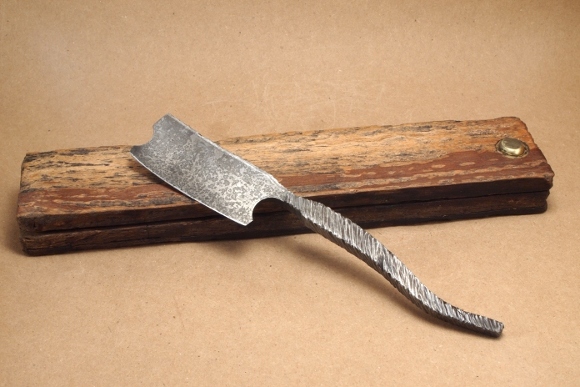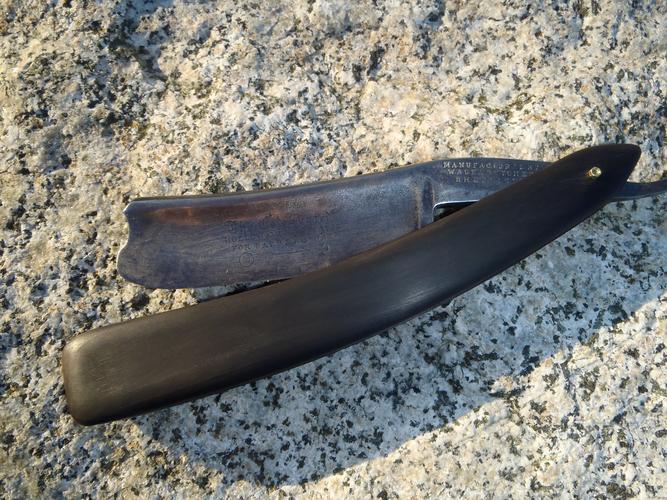Results 11 to 19 of 19
Thread: creating patina
-
11-22-2013, 01:13 PM #11

Here is one that got the bluing bleach treatment, the blade portion shows the surface it makes. I used cold blue then used a tooth brush to flick little droplets of bleach onto the surface. I went through several iterations of blue then bleach to get the look I was going after. It also looks good dipping the whole blade in the bleach. I have also dabbed on bleach with q-tips, used bleach soaked saw dust, dabbed the surface with crumpled up brown paper bag. The method leaves room for lots of experimentation. I would get to a good 600 grit before starting the process.
Charlie

-
The Following 5 Users Say Thank You to spazola For This Useful Post:
Geezer (11-22-2013), miha (11-22-2013), pfries (11-22-2013), RezDog (11-22-2013), ScottGoodman (11-22-2013)
-
11-22-2013, 01:33 PM #12

@charlie: If I understand correctly there was no surface touching up after 600 grit and applying patina? I am not familiar what cold blue does, is it used for de-greasing?
some of a bunch of questions I have considering this technique :
:
What are the approximate times of incubation for oxidizing with bleach or vinegar, did anyone try stronger acids?
I am thinking of maybe trying a partial oxidation, eg etching like patina, or patina on the tang only or sth like this,.. if someone did this before, how did you limit the oxidizing agent effect, the way some etchings are applied (it looks like tar like protection), maybe "solid state" grease, taping maybe?
-
11-22-2013, 04:35 PM #13

I will clean up the surface with high grit sandpaper 1500-2000 and metal polish. What I meant by cold blue is the liquid bluing that is used on guns to turn the metal blue and blackish.
I am not really sure of the time, maybe 5 or 10 minutes. I just watch it and wipe it off when I like the way it looks.
I have used nail polish and shellac as masking when making patinas. You could mask the the parts you do not want done with nail polish.
Charlie
-
-
11-22-2013, 04:46 PM #14

Thanks Charlie, nail polish sounds great
 . Not much of a gun person so didn't know what to connect the cold blue with (google knows many cold blue things
. Not much of a gun person so didn't know what to connect the cold blue with (google knows many cold blue things  )
)
Have a nice weekend you all !
!
-
02-28-2014, 09:23 PM #15

RezDog, any results yet?
"Bore Brother Bore!"
-
02-28-2014, 09:47 PM #16Senior Member




- Join Date
- Feb 2013
- Location
- Haida Gwaii, British Columbia, Canada
- Posts
- 14,450
Thanked: 4829
Results I have pictures I don't. I don't have my tripod with me and I'm at work for another week. I have also been working on getting a new set of horn scales to look old. Mixed success with the scales but the blue and bleach was very easy to do and I got a nice patina as far as I'm concerned. I will try a couple of free hand pictures later if I can get outside. The colors are alway bad inside and the flash really throws everything off too.
It's not what you know, it's who you take fishing!
-
03-01-2014, 02:03 AM #17Senior Member




- Join Date
- Feb 2013
- Location
- Haida Gwaii, British Columbia, Canada
- Posts
- 14,450
Thanked: 4829
At this point this is where I have gotten to. The scales are still a work in progress. I'm not sure if they look old or just satin finished. I was trying to get them to the point where they look a little silvery in spots with some grain exposure. Not sure if I will get there this time. The blade is pretty close. Just requires a little darkening next to the stabilizers and it should be satisfactory.

 It's not what you know, it's who you take fishing!
It's not what you know, it's who you take fishing!
-
03-01-2014, 02:35 AM #18

The historic/replica gun-builder guys are nuts about this. Browse around "American Longrifles" for a bit.
I don't care for the pattern that bleach leaves in all the examples i've seen on bbl steel. I like browning/bluing and rubbing back to a grey/silvery/black finish, for longrifle hardware in steel.Buttery Goodness is the Grail
-
03-07-2014, 04:22 PM #19Senior Member



- Join Date
- Apr 2012
- Location
- Diamond Bar, CA
- Posts
- 6,553
Thanked: 3215
French’s Mustard also works on a heated blade, run under hot water, dried and applied with the edge of a hand torn sponge or crumpled piece of saran wrap for the random patina look. Or to darken etch and tang stamping buff off excess with Wet & Dry and of 000 steel wool.
The paste like consistency of mustard allows you to pattern the etch as opposed to flooding with liquid. I like Charlie’s idea of the toothbrush for random darkening.
The longer you leave it the darker it gets, overnight is good for dark. Thinner application seems to work better for darker patina. Several coating give a very random pattern and highlite areas, mask with nail polish or painters tape.
There are video and pictorials on knife forums.Last edited by Euclid440; 03-07-2014 at 04:55 PM.


 18Likes
18Likes LinkBack URL
LinkBack URL About LinkBacks
About LinkBacks







 Reply With Quote
Reply With Quote